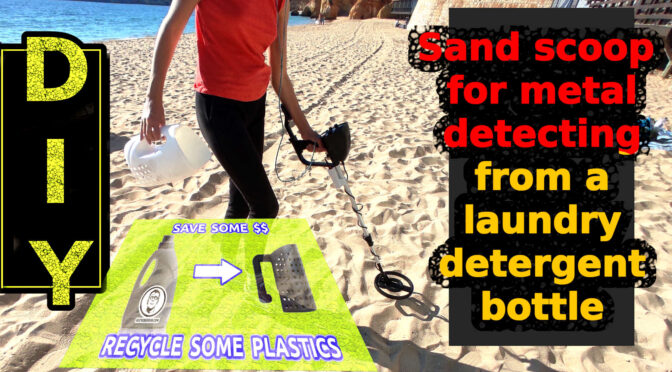Welcome to our DIY guide on creating your very own metal detector sand scoop using a simple laundry detergent bottle.
Metal detecting is not only a source of excitement and adventure but also a hobby that can contribute positively to history, culture, community, and the environment while promoting physical activity and education.
Fashioning a sand scoop for metal detecting from an old plastic detergent bottle is not only a cost-effective and eco-friendly approach but also a creative DIY endeavor that repurposes plastic waste into a functional tool, contributing to environmental sustainability.
With a few basic tools and materials, you can transform an everyday household item into a functional tool for your metal detecting adventures. Let’s get started!

Materials Needed
- Empty laundry detergent bottle
- Sponge and Alcohol(20ml-30ml) > 90%
- Marker
- Cutter
- Scissors
- Soldering iron or Rotary Tool (Dremel) or Drilling Machine with Step Drill bit
Step 1 Prepare the Bottle
Start by thoroughly cleaning and drying the empty laundry detergent bottle. Remove any labels or residue from the surface. This will ensure a clean and smooth working surface. You can use sponge and alcohol to speedup the process of removing the glue from the stickers.
Step 2 Mark the Cutting Lines
Using a marker and ruler and mark the desired shape and size of your sand scoop on the bottle. You can customize the dimensions based on your personal preferences and the size of the bottle you are going to use.
Step 3 Cut the Bottle
Carefully cut along the marked lines using a cutter and scissors. Take your time and follow the lines as accurately as possible.
Step 4 Create Holes
Make several evenly spaced holes on the bottom and in the area of 10cm-15cm over the base of the scoop. These holes will allow sand and small particles to fall through while retaining any metal objects. To accomplish this, you have few options depending on the available tools. You can remove the plastic leftovers around the holes with cutter knife.
Soldering Iron: When using a soldering iron to create holes in the detergent bottle, there is a potential risk of inhaling toxic fumes. The plastic from the bottle can release harmful chemicals when heated, such as plasticizers and other volatile organic compounds, which can be harmful when inhaled. It is essential to work in a well-ventilated.
Rotary Tool: Using a rotary tool, like a Dremel, to make holes in the plastic bottle may produce micro plastic waste. The high-speed cutting action can generate tiny plastic particles that scatter in the environment. It is advisable to perform this task in a controlled workspace with proper dust extraction equipment to minimize the release of micro plastic waste into the environment.
Driller: Drilling holes in the detergent bottle with a power drill also poses a risk of generating micro plastic waste. The drill bit can create plastic shavings that become airborne and potentially contribute to plastic pollution. To mitigate this risk, work in a designated area, wear protective gear, and use a vacuum or dust collector to contain the plastic debris.
In all cases, it’s essential to prioritize safety by wearing appropriate personal protective equipment, working in well-ventilated spaces, and taking precautions to minimize environmental impact, such as properly disposing of plastic waste and cleaning up any plastic particles generated during the project.
Step 5 Test the Sand Scoop
Take your newly created metal detector sand scoop to a sandy area for testing. Scoop up some sand and give it a few shakes to see how well the holes filter out unwanted materials while keeping the metal objects in the scoop.
Step 6 Make Adjustments (Optional)
If you find that the sand scoop is not working as effectively as desired, you can make adjustments. You can increase or decrease the hole sizes, add more holes, or modify the shape to better suit your needs. Experimentation is key to finding the perfect design.
Conclusion: Congratulations! You have successfully transformed a simple laundry detergent bottle into a useful metal detector sand scoop. By following these easy steps, you can save money and create a practical tool for your metal detecting adventures. Remember to always prioritize safety while handling tools and enjoy your treasure hunting!
With the video clip below, you can visually follow each step of the process. Good luck with this project and happy metal detecting!
The person / group of people involving in making the projects presented in this website are solely responsible for their results, good, bad or whatsoever.
Some of the links on this article are affiliate links, meaning, at no additional cost to you, we may earn a commission if you click through and make a purchase and/or subscribe.


Leave a Reply